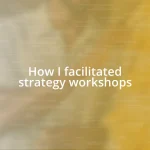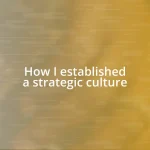Key takeaways:
- Genuine connections with stakeholders through personal engagement and active listening lead to better insights and project outcomes.
- Tailoring communication strategies to meet the preferences of diverse stakeholders enhances clarity, fosters trust, and enriches collaboration.
- Implementing feedback mechanisms and visually evaluating engagement outcomes can transform stakeholder contributions into integral parts of the project, driving emotional investment and innovation.

Understanding stakeholder engagement
Understanding stakeholder engagement goes beyond just a checklist of tasks; it’s about forming genuine connections. I remember a particular project where I reached out to stakeholders personally, inviting them for coffee to discuss their concerns. It struck me how a simple conversation can turn into a profound understanding of their needs and expectations.
When I think about successful stakeholder engagement, the emotional component cannot be overlooked. Have you ever felt ignored in a decision-making process? I have, and it motivates me to ensure that others feel valued and heard. Creating an environment where stakeholders feel safe to express their opinions leads to richer insights and ultimately better outcomes.
It’s fascinating how different perspectives can transform a project. I engage stakeholders through active listening; I truly immerse myself in their viewpoints. This engagement is not merely about gathering input, but about weaving together a tapestry of ideas that reflects the diversity of thoughts. Have you considered how a collaborative approach can elevate your project to new heights? Engaging stakeholders isn’t just good practice; it’s essential for success.

Identifying key stakeholders
Identifying key stakeholders is akin to assembling a puzzle; each piece plays a crucial role in creating a complete picture. In my experience, I often start by mapping out various groups or individuals impacted by the project. Once I outline those connections, it’s enlightening to see how stakeholders can shift from just names on a list to real people with unique needs and expectations.
Here’s a quick approach I’ve found helpful for identifying key stakeholders:
- Assess impact: Consider who will be directly affected by the project.
- Evaluate influence: Identify individuals or groups that hold sway in decision-making or project success.
- Map interests: Understand what each stakeholder cares about most regarding the project.
- Leverage existing relationships: Think about who you already know within these groups; personal connections can foster trust.
In one project, I discovered a stakeholder who initially seemed insignificant but ended up having crucial insights that shaped our direction. It’s these surprising connections that often lead to epiphanies in planning.

Developing a communication strategy
Developing an effective communication strategy is essential for engaging stakeholders meaningfully. I remember crafting a detailed plan that outlined how often and through which channels I would communicate. This involved everything from emails and newsletters to informal catch-ups. It was gratifying to see how an effective strategy kept everyone informed and engaged. Have you ever noticed how consistent communication not only builds trust but also fosters a collaborative spirit? In my experience, it can be the glue that binds diverse perspectives together.
At its core, a communication strategy should be rooted in clarity and transparency. I’ve often found that stakeholders appreciate straightforward updates about progress, challenges, and opportunities. One time, I organized a bi-weekly meeting to address any concerns and share relevant data. This open forum not only illuminated potential roadblocks but often turned into brainstorming sessions that revitalized our approach. By ensuring that stakeholders felt heard and involved, we cultivated a sense of ownership that significantly enhanced their commitment to the project.
It’s worth mentioning that tailored communication is crucial. Different stakeholders have varying preferences and interests that must be considered. I once worked on a project with technical experts who preferred detailed reports, while community members favored concise summaries. Knowing this allowed me to create segmented content that catered to each group’s needs, enhancing their engagement. Balancing diverse communication styles fosters inclusivity, ultimately enriching the decision-making process.
| Communication Method | Target Audience |
|---|---|
| Email Updates | General Stakeholders |
| Bi-weekly Meetings | Project Team |
| Informal Catch-ups | Key Individuals |
| Social Media Posts | Wider Community |

Conducting stakeholder analysis
Conducting a stakeholder analysis is a vital step in planning, and I can say from experience that it sets the stage for genuine engagement. I’ve often used a grid to categorize stakeholders by their level of influence and interest. This approach not only clarifies who should be prioritized but also helps to identify potential allies or adversaries. Have you ever found yourself overlooking a stakeholder who could have provided valuable insights? I’ve learned the hard way that neglecting even minor players can come back to bite you during implementation.
During one project, I discovered that a seemingly peripheral stakeholder, a local business owner, actually had deep ties within the community. By involving him in discussions early on, I gained access to a wealth of community sentiment that would have otherwise gone unacknowledged. It’s fascinating how one individual’s perspective can shift the entire narrative, demonstrating the importance of seeking out diverse opinions. I remember feeling surprised but grateful when this engagement helped us to uncover community concerns that eventually shaped our approach.
I’ve also found that value-based conversations can deepen stakeholder analysis. For instance, asking open-ended questions about what matters most to them can reveal motivations that aren’t immediately visible. I once engaged a group of environmental advocates—what I thought would be a routine discussion turned into a vibrant dialogue, unearthing shared goals that we could leverage as a united front moving forward. It reinforced my belief that an open, genuine dialogue can yield insights and connections that dramatically enhance a project’s trajectory. Isn’t it rewarding to discover common ground when you least expect it?

Creating a collaborative environment
Creating a collaborative environment starts with setting the right tone. I once facilitated a workshop where I encouraged everyone to share their thoughts freely, regardless of their role. Witnessing the shift from hesitance to animated discussion among participants was a highlight for me. It reminded me how crucial it is to create a space where everyone feels valued and safe to express their ideas. Have you ever noticed how a relaxed atmosphere can lead to surprisingly innovative solutions?
Another aspect I’ve found essential is active listening. Once, during a brainstorming session, I made it a point to reflect back what participants said before moving on to the next topic. This simple act of acknowledgement sparked deeper discussions. Suddenly, those who were quiet began to share their insights, realizing that their contributions mattered. It was a powerful moment, illustrating just how important it is for leaders to validate every voice in the room. Don’t you think that recognizing someone’s perspective can illuminate paths to collaboration that might otherwise remain hidden?
Moreover, utilizing collaborative tools can greatly enhance participation. I experimented with online platforms that allowed real-time feedback and idea sharing, such as digital whiteboards. I recall one project where this approach transformed dry meetings into dynamic exchanges filled with creativity. It was exhilarating to see ideas morph right before our eyes, underscoring the notion that collaboration isn’t just about talking; it’s about actively creating together. Isn’t it amazing how technology can break down barriers and foster inclusivity?

Implementing feedback mechanisms
Implementing feedback mechanisms is crucial for refining plans and ensuring stakeholder voices are truly heard. In one project, I established a simple online survey to gather input from stakeholders after a major meeting. Seeing the range of responses poured in was exhilarating; it felt like everyone was joining the conversation even when the formal setting had ended. Have you ever watched a project transform because of a few key pieces of feedback?
I remember another instance when I organized focus groups, allowing more in-depth discussions about our approach. The insights gained were eye-opening! Stakeholders offered alternative perspectives I hadn’t considered, and it was a humbling reminder that sometimes, stepping back can fuel progress. Engaging them in this manner not only boosted their commitment but also made them feel integral to our shared success. Isn’t it fascinating how creating space for open feedback can spark innovation?
Additionally, I learned the power of follow-up. After a stakeholder shared a concern about environmental impact, I committed to providing updates on our progress addressing it. This transparency fostered trust and reaffirmed the notion that their voice really mattered. When stakeholders see that their input directly influences decision-making, they become more engaged. How often do we, as facilitators, overlook the importance of keeping that dialogue going?

Evaluating engagement outcomes
Evaluating engagement outcomes is where the magic of our collaborative efforts often reveals its true impact. After implementing feedback mechanisms, I took the time to analyze the data gathered. One time, when reviewing survey responses, I was surprised by the themes that emerged. It was enlightening to see what resonated most strongly with stakeholders. Have you ever unearthed insights that completely shifted your perspective on a project?
To truly gauge the success of our engagement, I initiated follow-up conversations. I vividly recall a meeting where we discussed not just the outcomes, but also how stakeholders felt about their involvement. The passionate exchanges left me exhilarated; it was clear that their emotional investment in our plans was a vital ingredient in our collective success. Isn’t it intriguing how emotional engagement can sometimes be just as crucial as the metrics we often focus on?
Additionally, I found that visualizing engagement outcomes can be quite powerful. During one project, I created a visual dashboard that showcased participation levels and sentiment analysis from our feedback. Watching stakeholders see their contributions represented graphically sparked new energy in the group. It was as if those insights transformed numbers into narratives. How often do we overlook the visual aspect of sharing our progress, and how can that help keep everyone excited and engaged?















